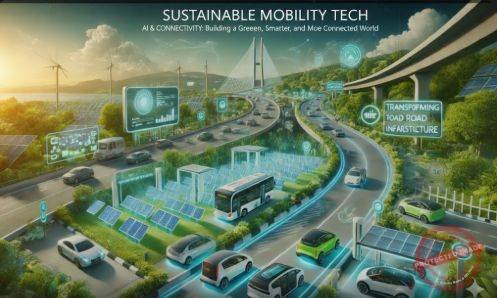How Clean Energy, Circular Design, and Smart Innovation Are Driving the Future of Eco-Friendly Transportation.
Sustainability Becomes the Core of Mobility Innovation
The future of mobility is not just about moving faster or smarter—it’s about moving responsibly. As cities expand, emissions rise, and resources dwindle, the transportation industry is undergoing a massive transformation toward sustainable mobility technology.
From electric scooters and solar-powered bikes to recycled materials and AI-driven energy optimization, today’s mobility gadgets are redefining what it means to travel efficiently and ethically.
Sustainability is no longer a side feature—it’s the foundation of next-generation mobility ecosystems.
The Green Shift: Electrification Everywhere
Electrification sits at the heart of the mobility sustainability revolution. The proliferation of electric mobility gadgets—e-bikes, scooters, compact EVs, and smart skateboards—is eliminating emissions one ride at a time.
Modern innovations include:
-
High-density lithium and solid-state batteries for greater range and lower environmental impact.
-
Solar-charging capabilities integrated into portable vehicles and accessories.
-
Swappable battery systems that minimize waste and downtime.
-
Smart charging infrastructure powered by renewable grids.
With governments worldwide setting aggressive carbon-reduction targets, electrified mobility is not just a trend—it’s an environmental necessity.
Circular Design and Sustainable Materials
Sustainability extends beyond power sources—it’s built into the materials, lifecycle, and recyclability of modern devices.
Manufacturers are adopting circular economy principles, ensuring that every component can be reused, repurposed, or recycled.
Examples include:
-
Frames made from recycled aluminum and carbon composites.
-
Biodegradable polymers replacing plastic in accessories.
-
Modular construction that allows repair rather than replacement.
-
Battery reclamation programs to recover valuable minerals responsibly.
These practices are turning mobility devices into zero-waste technologies that minimize environmental footprint from production to disposal.
AI and Data: Optimizing Sustainable Performance
Artificial Intelligence plays a pivotal role in making mobility gadgets more energy-efficient and sustainable.
-
Predictive maintenance extends product life and reduces material waste.
-
Energy optimization algorithms adjust power output to terrain and usage patterns.
-
Smart routing reduces travel time and energy consumption.
-
Fleet analytics ensure shared mobility systems operate with minimal idle time.
By merging sustainability with intelligence, AI transforms mobility from a consumer product into an eco-conscious system that balances efficiency and responsibility.
Smart Cities and Sustainable Infrastructure
Sustainable mobility cannot thrive without equally smart infrastructure. Cities are investing heavily in ecosystems that support green, connected transport networks:
-
Solar-powered charging stations and renewable microgrids.
-
Dedicated e-bike and scooter lanes that improve safety and reduce congestion.
-
Smart parking systems that cut idling and emissions.
-
Data-sharing frameworks for urban planners to optimize traffic and reduce pollution.
Together, these innovations form the green arteries of tomorrow’s cities—where every device, vehicle, and grid contributes to environmental well-being.
Shared Mobility: Efficiency Through Collaboration
The sharing economy is amplifying sustainability across the mobility landscape. Shared fleets of electric scooters, bikes, and compact vehicles reduce production demand, minimize waste, and democratize access to eco-friendly transport.
Shared mobility platforms leverage IoT, AI, and digital payments to ensure efficiency and accountability, while municipalities enforce regulations for equitable access and safe operation.
When combined with renewable energy, shared mobility becomes a sustainable ecosystem of movement—one that benefits both people and the planet.
Challenges and the Road Ahead
Despite progress, challenges persist:
-
Battery sourcing and recycling remain environmental concerns.
-
Energy storage infrastructure must scale alongside demand.
-
Affordability and accessibility vary across regions.
-
Policy frameworks lag behind rapid technological growth.
Overcoming these barriers requires public-private collaboration, standardized sustainability certifications, and continued innovation in materials science and renewable technology.
Closing Thoughts and Looking Forward
Sustainable mobility is no longer an aspiration—it’s the blueprint for the future. The integration of clean energy, intelligent design, and connected infrastructure is setting the stage for a carbon-neutral transportation revolution.
As consumers, cities, and corporations align around climate goals, the next decade will redefine what mobility means.
The journey ahead isn’t just about reaching new destinations—it’s about ensuring the planet remains one worth traveling.
In the new era of mobility, progress moves on two wheels, one charge, and zero emissions.
References
-
“Sustainable Urban Mobility: A Global Transition” – World Economic Forum
https://www.weforum.org/agenda/2024/08/sustainable-urban-mobility-global-transition -
“Electrification and the Green Mobility Revolution” – McKinsey & Company
https://www.mckinsey.com/industries/automotive-and-assembly/our-insights/electrification-and-the-green-mobility-revolution -
“Circular Design in the Future of Transport” – Deloitte Insights
https://www.deloitte.com/insights/circular-design-in-the-future-of-transport -
“AI for Sustainable Energy and Mobility Systems” – MIT Technology Review
https://www.technologyreview.com/2024/10/05/ai-for-sustainable-energy-and-mobility -
“The Shared Mobility Sustainability Index 2024” – Forbes Tech Council
https://www.forbes.com/sites/forbestechcouncil/2024/09/17/the-shared-mobility-sustainability-index-2024
Author: Serge Boudreaux – AI Hardware Technologies, Montreal, Quebec
Co-Editor: Peter Jonathan Wilcheck – Miami, Florida
Post Disclaimer
The information provided in our posts or blogs are for educational and informative purposes only. We do not guarantee the accuracy, completeness or suitability of the information. We do not provide financial or investment advice. Readers should always seek professional advice before making any financial or investment decisions based on the information provided in our content. We will not be held responsible for any losses, damages or consequences that may arise from relying on the information provided in our content.



